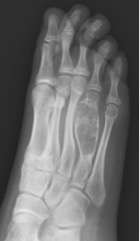Description
Unicameral Bone Cyst (UBC) is a very common benign bone tumor in children. It is a space in the bone that is filled with fluid instead of with bone. It usually occurs in the long bones near a joint and growth plate, such as near the knee, hip, or shoulder. They are usually not painful unless there is also a fracture (break) in the bone through the UBC.
UBCs are filled with fluid and are usually near a growth plate. They only occur in one bone in the body.
The cause of a UBC is unknown although there are many theories. UBCs can change in size and shape as your child grows. However, once your child stop growing, the UBC typically will stop growing and may fill in with normal bone on its own.
Symptoms
UBCs may not cause any symptoms. It is rare for a UBC to lead to a mass that you can feel unless there is a fracture (break in the bone). UBCs can get large enough that the bone is weakened, which is what leads to the fracture, and this is typically how UBCs are discovered in a child.
UBCs are classified as Active and Latent.
Active – the UBC is near the growth plate and getting bigger in size.
Latent – the UBC is away from the growth plate.
Doctor Examination
Your doctor will talk to you and your child about his or her medical history as well as any symptoms that occurred before the UBC was found on the x-ray. He or she will ask about any history of trauma, any pain, pain with activities, or pain during the night.
Your doctor will see if there are any bony lumps, and whether those areas are painful. He or she will also check how the motion is in the joints near the affected area.
Studies

An active UBC in the 4th metatarsal bone (blue arrow). The UBC is next to the growth plate in the bone and is large.
CT Scan - A CT scan can show how big the UBC is, how much normal bone is left, and whether there is thinning of the bone that is concerning for weakening that may lead to a fracture. Your doctor will determine if a CT is necessary.
MRI - A MRI will show the fluid in a UBC, and this can help make the diagnoses of UBC, especially if the X-ray cannot tell whether it is an ABC or UBC. Your doctor will determine if an MRI is necessary.
Biopsy - If the diagnosis cannot be made based on imaging, your doctor may recommend a biopsy, where a sample of the cyst and fluid is obtained.
Treatment
Nonoperative:
Small UBCs that are not causing symptoms can be treated by observation and repeating X-rays to watch the size of the UBC. Sometimes your doctor may ask your child to decrease activity and sports if there is a concern that a fracture could occur through the cyst.
Your doctor may recommend surgical treatment, however, if there is a fracture through the UBC, if the UBC is very large and may cause the bone to be weak, or if your child is having pain. Many times, especially if the fracture is in the arm and not the leg, your surgeon may recommend waiting for the fracture to heal on its own before recommending surgery. Sometimes the UBC will even go away on its own after the fracture heals.
Aspiration and Injection:
While your child is asleep, a large needle can be placed inside the cyst to drain the fluid. Material is then injected into the cyst through the needle to decrease the chance that the cyst comes back. It is common to need several injections.
Curettage and Grafting:
Curettage involves scraping the lining of the cyst out of the bone with special tools. Your surgeon may then fill the hole in the bone with cement, bone graft, or a bone graft substitute that is made in a lab. Bone graft can be bone from your child’s own body (autograft) or bone from another person (allograft). Sometimes, your surgeon may also put a chemical in the hole to try to prevent the tumor from coming back.
Outcomes
The chance of the UBC coming back after surgery is very common, about 25-50% of the time. This can be very frustrating for you, your child, and your surgeon! Because of this, your child will need to have regular x-rays and appointments with their doctor. The good news is that UBCs do not turn into cancer, and they will gradually go away on their own when your child is done growing.

 POSNA.org
POSNA.org
